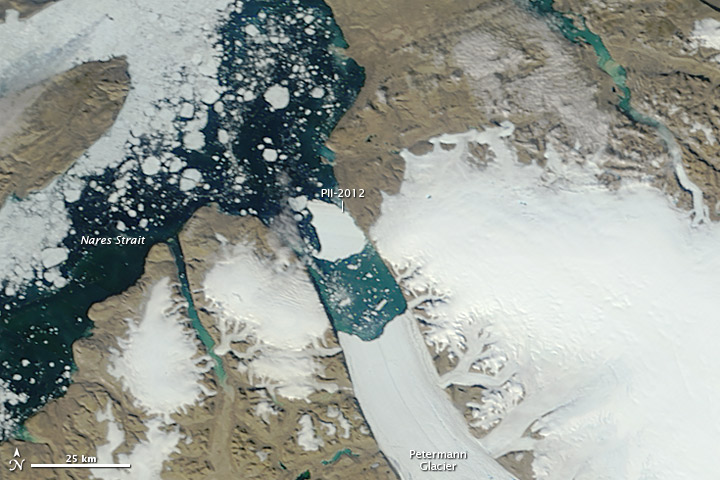
Photo Reveals Giant Greenland Iceberg Heading to Sea

A massive iceberg that recently cleaved from one of Greenland's largest glaciers has made its way down the fjord that confines it and is poised to float out into an ocean strait, satellite photos reveal.
The giant berg, about 46 square miles (120 square kilometers) in size, broke away from the Petermann Glacier in northwest Greenland on July 16. In the nearly three weeks since, the iceberg, dubbed PII-2012, has drifted some 14 miles (22 km) and rotated about 90 degrees counter-clockwise.
Satellite images captured on Monday (July 30) show the berg has nearly reached the mouth of a fjord that opens on the Nares Strait, a narrow stretch of ocean that separates Greenland from Canada.
Andreas Muenchow, an associate professor at the University of Delaware who has been tracking PII-2012's progress with satellite data, wrote on his blog that the berg has picked up a bit of speed in recent days. Last week it was traveling about two-thirds of a mile (1 km) each day, yet over the weekend of July 28, the ice island doubled its pace.
Researchers first noticed the growing crack that would break PII-2012 from the Petermann Glacier's ice shelf — the forward edge of the glacier, which floats on the ocean — several years ago, when sifting through satellite images taken in 2001.
In the intervening years, scientists watched the crack, which some of them dubbed "The Big Kahuna,"extend its reach across the ice shelf, and predicted last autumn that a berg would finally break away during the warm summer months of 2012.
When the iceberg finally does emerge into the Nares Strait, it could pose problems for ships trying to navigate the narrow ocean channel, Muenchow said. "Without a break-up, it is big enough to block the channel as another large ice island did for almost 6 months in 1962," he wrote on July 31.
Sign up for the Live Science daily newsletter now
Get the world’s most fascinating discoveries delivered straight to your inbox.
The Petermann Glacier and other glaciers wend through Greenland's ice sheet, essentially serving as slow-moving conveyor belts. They move ice from the middle of the frigid island to the sea, where it forms the colossal, floating plains called ice shelves that, from time to time, give birth to enormous icebergs
However, these floating ice plains also buttress up the glaciers that feed them, slowing their progress into the ocean. Research has revealed that when ice shelves weaken or collapse entirely, glaciers speed up, moving more ice off of land and into the ocean and raising global sea levels.
The Petermann Glacier's newest iceberg birth has shrunk its ice shelf significantly, according to both Muenchow and scientists with the National Snow and Ice Data Center.
Reach Andrea Mustain at amustain@techmedianetwork.com, or follow her on Twitter @AndreaMustain. Follow OurAmazingPlanet on Twitter @OAPlanet. We're also on Facebook & Google+.









